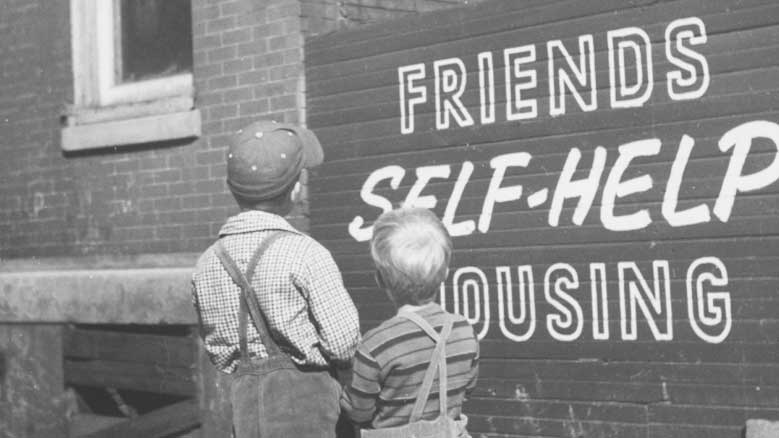
Over the past two years a small group of Norristown (Pa.) Meeting members has been exploring ways for the meeting to engage in our neighborhood and expand the amount of quality, affordable housing in the area. Norristown is a former manufacturing town and the county seat of prosperous Montgomery County. However, the median income in Norristown is $41,856, about half the county average. Yet median rents in Norristown are $1,011, compared to the county average of $1,158, and 60 percent of Norristown residents are renters. Quality affordable housing is scarce, while high prices, poorly maintained properties, and inattentive landlords are all too common. Learning more about the needs of this community and about the social and economic benefits of affordable housing has led to a vision: the development of a nonprofit apartment building across the street from and owned by the meeting.
There is a rich legacy of Quakers working to make housing affordable and accessible. Abington Quarterly Meeting’s history includes funding a boarding home for older Friends that was in operation until the early 1970s and located near Norristown Meeting. The quarter’s Home and Care Committee manages funds that were initially endowed by Quaker philanthropist Anna T. Jeanes in 1896 “to assist in the establishment and maintenance of Boarding Homes for the aged and infirm amongst Friends and those in sympathy with us.” (She gave $200,000 to set up eight quarterly meeting homes for elderly Quakers of Philadelphia Yearly Meeting.) Today the committee still provides financial support and pastoral care for older Friends.
I can trace my own interest in affordable housing back to the mid-1990s, when I joined the Religious Society of Friends and Haverford (Pa.) Meeting. One of the first Quakers I met there was Margaret Collins, an activist who in 1956 founded a real estate firm named Friends Suburban Housing with the mission of helping African Americans gain fair access to housing.

When I got to know Margaret she was in her 80s and quietly working in a lower-income Delaware County, Pa., community installing first-floor bathrooms in the houses of elderly and disabled people, enabling them to live longer in their own homes. On Saturday mornings she’d pick me up in her old Ford wagon full of two-by-fours, and off we’d go, stopping by one building after another to check on something or someone.
Twenty-five years later, following worship one Sunday at Norristown Meeting, I met N’ann Harp, who had returned to the Norristown community after many years away. She brought accumulated experience from careers in construction, consumer advocacy, and activism. A recent graduate of Pendle Hill’s Radical Faithfulness in Action program, I felt drawn to her energy and story. For many years N’ann ran a design–build contracting business in the Washington D.C. metropolitan area. Her business grew quickly through client recommendations, and she built herself a comfortable life, but as she says, the work wasn’t meeting her “inner call for a social purpose or service.”
Years later she decided to make a radical life change to better understand the reality of housing and homelessness in the United States. On New Year’s Day 2012, she set out on what she calls a “walkabout”—a sojourn of voluntary poverty and homelessness—experiencing first-hand what it’s like to exchange room and board for farm work (WOOFing), to live around former prison inmates in a boarding house, or to sleep among other homeless people in a shelter dormitory. She ended her walkabout on New Year’s Day 2019.
When we met, N’ann and I quickly realized we shared an interest in equitable, affordable housing. In the fall of 2017, we taught a course at Cabrini University, where I teach, called “Housing Access and Affordability,” working with students to study different affordable housing models. Our goals were to identify what could work in our local community and to explore models that could have a national impact. N’ann and the students helped educate me about the long Quaker history of cooperative housing in Philadelphia, Pa. Students read about the creation of Friends Housing Cooperative in 1952 and the Life Center Association co-op in West Philadelphia in 1971.
We simultaneously began a dialogue with members of our meeting community to seek out their input. It was suggested that an apartment-based model would more likely be welcomed than typical cooperative ownership. So meeting and community members worked together with Cabrini University students to develop a vision of a nonprofit apartment building that operates using cooperative principles and includes a savings component.
During 2017 N’ann and I began introducing ourselves to folks on the adjacent blocks of Swede Street. In doing so we met two sets of significant neighborhood activists. One was a Mennonite senior couple who’ve been quietly renting small apartments at below market rates for the past 20 years. The other was Laurel House, a nonprofit domestic violence agency headquartered on the same block. The executive director shared that they were constantly struggling to find affordable apartments for women exiting their shelter program. She also said that the agency was preparing to sell one of their licensed apartment shelters—a building located across the street from Norristown Meeting.
During the summer of 2018 another group of Cabrini students was researching housing issues. They had come across an organization in Ohio whose dividend housing model was remarkably similar to the one our group was envisioning, and it had been running for over a decade.
I quickly connected with the group’s founder, Margery Spinney, who is also the inventor of dividend housing, a system designed to provide residents with the opportunity to build wealth over time as they pay rent on time, participate in regular community meetings, and complete assigned work tasks. Its “equity credits” are funded through reduced turnover and lower maintenance costs as well as through lower financing costs than those of a traditional for-profit building. Margie began freely sharing their model and experience with us.
This past May, we presented a project overview for internal discussion at Abington Quarterly Meeting. The draft document lays out our operational and financial plan to purchase and convert the building currently owned by Laurel House (a three-story double twin house) into an intergenerational housing community using the dividend housing model. Norristown Meeting recently passed a minute of support. Other encouraging updates include: Home and Care Committee has stated their willingness to support local Quakers wanting to live in the property (other residents will come from Laurel House and the Norristown community); several individual investors have stepped forward; and the municipality has confirmed that our intended use is consistent with local zoning. As way continues to open, we’re hopeful to turn this vision into reality.



Very impressive story…will inspire All that have access to what some Quakers and nonQuakers can support. Thanks for info
I was interested to read about the history of Friends Suburban Housing and the Abington Quarter’s work in developing affordable housing. My experience developing affordable housing was the most gratifying that I’ve been involved in to date. Susan Davies and I (then Martha Solish) from Cambridge Meeting in Massachusetts founded Women’s Housing Initiative in 1987 to create affordable rental housing in the poorer neighborhoods of Boston. We negotiated with the City and obtained rights to develop a derelict parcel of land. Cambridge Meeting loaned us a $200,000 bridge loan out of their endowment (2 years’ term) which provided the early support to enable us to bring in other funds. With the addition of fundraising and financing, strong community support, architects and contractors, and creation of a POC-led not-for-profit organization to own and run it in the long term, Brookview House took shape. Originally set up as 8 apartments for homeless single parent families headed by women, it has expanded and grown into a strong community based agency providing housing, employment support and programs for kids and teens. This year, Brookview House celebrates its 30th anniversary! The open-hearted early support of Cambridge Friends Meeting made it possible.
Eric: The info you requested about Martin Niemoller was contained in an article I wrote in CMC Digest in February 2020 titled “Words to Remember During the Donald Trump Era.” You should have no problem finding it. Just scroll back.
Beau